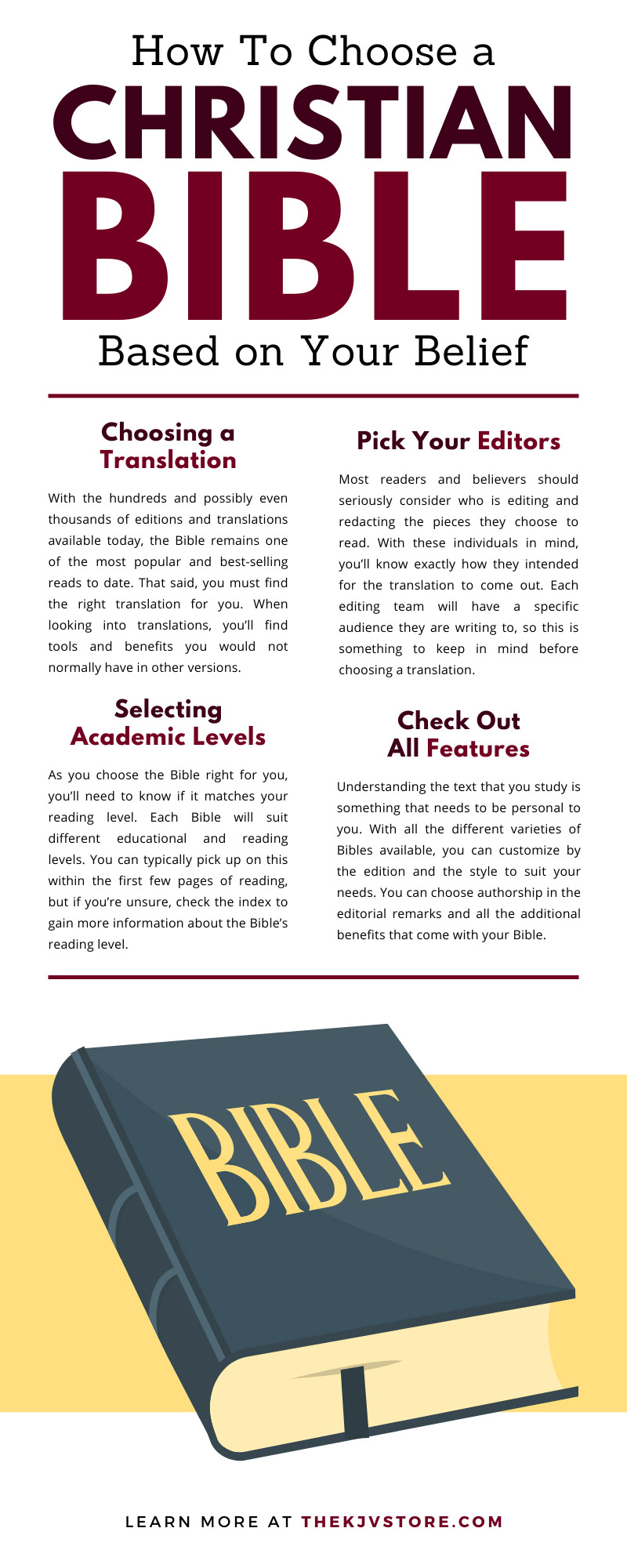How To Choose a Christian Bible Based on Your Belief

As a believer in a spiritual practice or tradition, there are certain guidelines you follow. You share in these practices with your fellow believers and millions of Christians around the world. However, the Bible you choose may look somewhat different than your neighbors. With centuries of history comes a variety of interpretations, and it’s essential that you find a Bible that aligns with your faith.
What you practice and what your faith-based congregation requires are only some factors that might determine how to choose a Christian Bible based on your belief. Read on to determine how to find an option that supports your spiritual needs and provides you with everything you need to practice your faith.
Choosing a Translation
With the hundreds and possibly even thousands of editions and translations available today, the Bible remains one of the most popular and best-selling reads to date. That said, you must find the right translation for you.
The reason why the right translation is so important is that it goes beyond just the language itself. When looking into translations, you’ll find tools and benefits you would not normally have in other versions.
These aspects are why there is a Bible for virtually everyone. No other book has experienced as many edits and publishing cycles as the Bible.
Take your time to discover the many nuances that make each version different so that you can have the version that is best for your needs. This is how you start off on the right foot when taking on such a monument of a literary masterpiece like the Bible.
Word-for-Word
When you’re looking at styles of biblical interpretation, there are generally two most readers rely on. One version is the word-for-word translation or the formal equivalence.
This method generally means that the audience it speaks to has a more formal and traditional approach to interpretation. This style is a literal look at what every word means in the original texts and involves studying the words individually and translating them directly.
The literal approach takes the text literally to form an “as is” approach, where editors and readers consider the direct translation as what carries the intended meaning. This delineates from thinking about the parable and interpretative thought such as symbolism. In a word-for-word translation, readers retain the historical sentiments, but further interpretation may be necessary to apply the lessons to modern-day living.
Thought-for-Thought
A modernized form of translation comes as a thought-for-thought style, also known as functional equivalence. This style presents ideas and perspectives through a broader scope by thoughts proposed in the reading.
This functional style is a more generalized form of interpretation that attempts to share the message on a generalized scale much larger than the formal equivalence. Many people associate this translation style with paraphrasing the message, popularized by many younger generations of believers. This style allows access to belief for those who aren’t as well-versed in the Bible as others, making it a more approachable option.
A Blended Style
Next, you can find blended translation styles that provide something for everyone.
In this style, you have the formal and foundational teaching with a literal translation and explanation. This type would include contextual clues in a sermon to round out the text and bring together the meaning of the words so that it can better illustrate the narrative.
Many people seek out the two styles together as it gives more supplementary material for a more thorough reading experience. A comparative thinker could greatly benefit from how they look at scriptural reading.
The comparative reader could use this style format to compare and contrast to find inner truths that might not be present in either form naturally laid out. Therefore, it offers a brand-new perspective for the person who chooses to use it for interpretive purposes.
Pick Your Editors
Most readers and believers should seriously consider who is editing and redacting the pieces they choose to read. With these individuals in mind, you’ll know exactly how they intended for the translation to come out.
Each editing team will have a specific audience they are writing to, so this is something to keep in mind before choosing a translation. Get to know the editors and ensure you understand what they were aiming to achieve.
With some editorial reviews, titles will focus on topics such as demographics, theology, or world issues. It’s wise to read up on the editors to see where they stand and what they target per translation. Knowing your version’s editor allows you to have a full context for each word on the page.
Selecting Academic Levels
As you choose the Bible right for you, you’ll need to know if it matches your reading level. Each Bible will suit different educational and reading levels. You can typically pick up on this within the first few pages of reading, but if you’re unsure, check the index to gain more information about the Bible’s reading level.
No reading level is necessarily a bad option. The goal is to find an academic level that suits you and makes reading an enjoyable and educational experience. These different reading styles open the doors for more readers and those who read to challenge their understanding by pushing their skills to the next level.
What is wonderful about this is that once you master this particular version, you can move on to other more advanced versions if you so choose.
Check Out All Features
Understanding the text that you study is something that needs to be personal to you. The more you read, the more the stories will give back.
With all the different varieties of Bibles available, you can customize by the edition and the style to suit your needs. You can choose authorship in the editorial remarks and all the additional benefits that come with your Bible.
If you like giant print KJV Bibles and maps to give you a greater understanding of the geography of the regions without putting a strain on your eyesight, there are Bibles for that too. Maybe you need more room for notetaking and referencing instead—in that case, seek wider margins.
Make sure you’re looking into all the given features so that you don’t miss out on anything that could potentially help you discover the perfect Bible that complements your needs.
If you’re in the market to purchase a Bible of your own and would like to know how to choose a Christian Bible based on your belief, use this list to determine what to look for. Remember that the right Bible for you is an entirely personal matter, so there is no one right answer.

